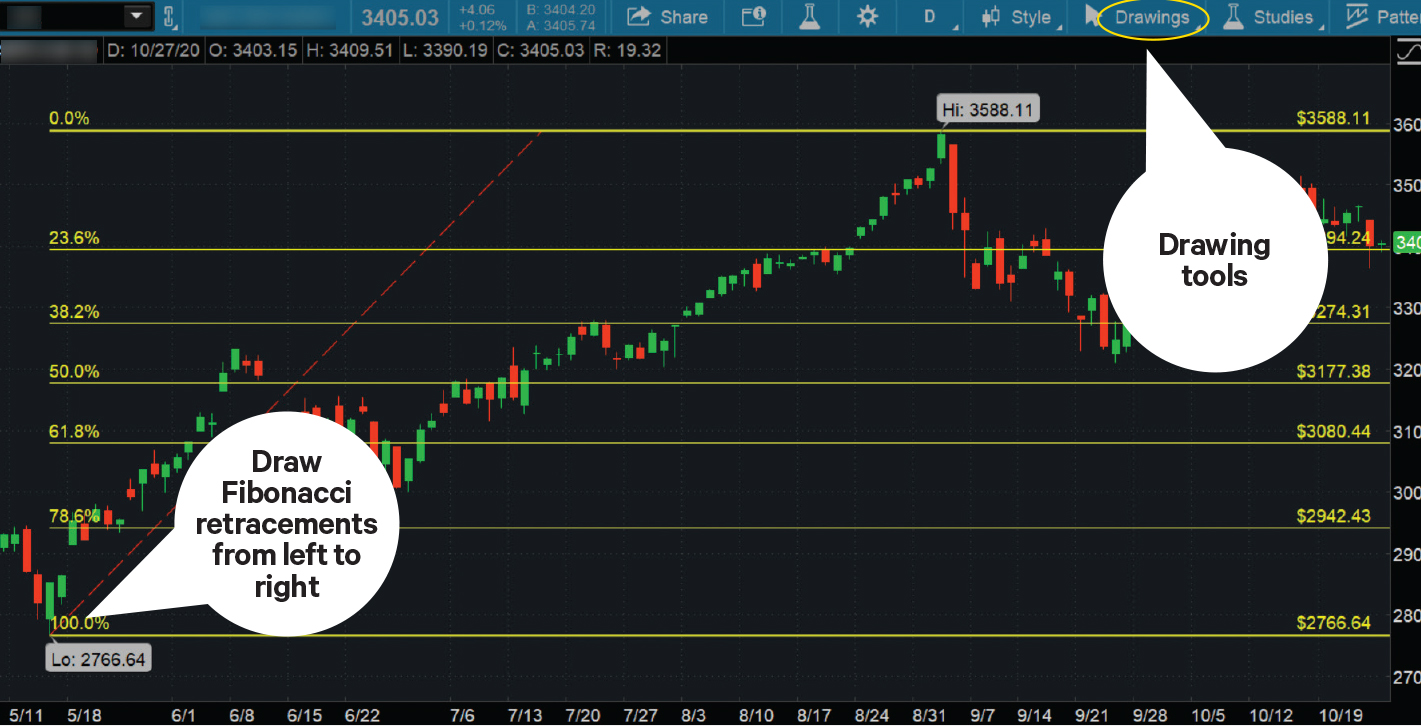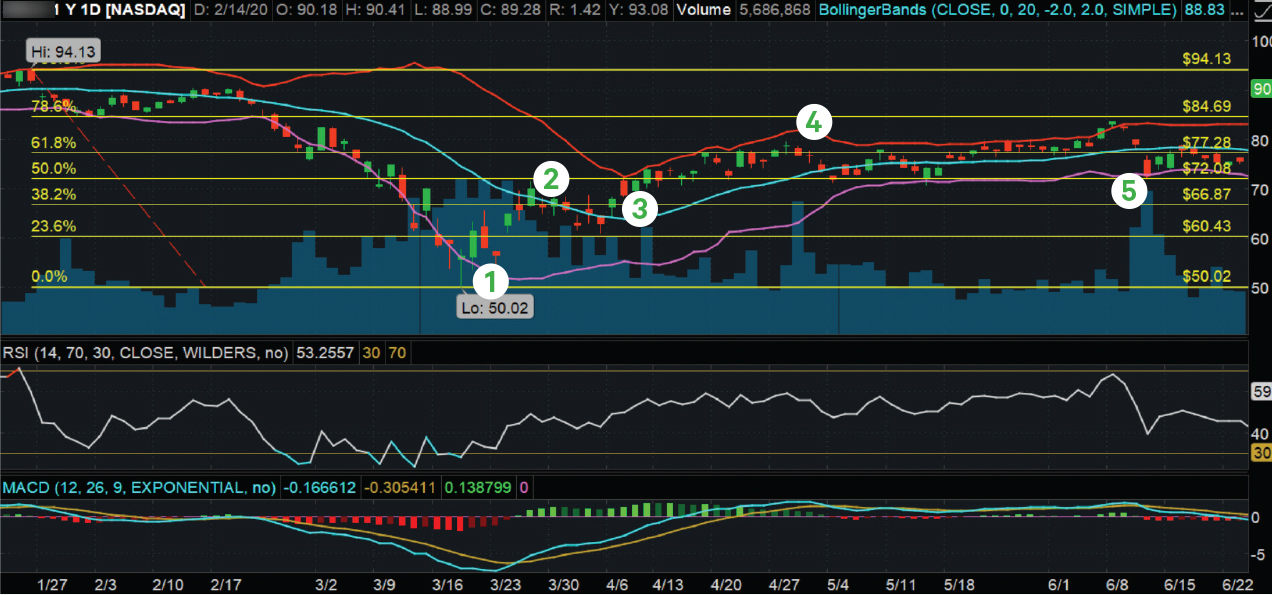How To Draw Horizontal Line In Thinkorswim
Charting for Traders: The 5 Biggest Charting Mistakes You're Probably Making
Whether you first started charting stocks on paper, software, or a smartphone, you lot're likely to make the aforementioned charting errors. Here'due south how to avoid falling into typical charting traps.

Photo by Dan Saelinger
Cardinal Takeaways
-
Beingness enlightened of some of the more than common charting errors could help you avoid making mistakes
- Understand the importance of coming up with a set of indicators that look at different types of price action
- Using a well-counterbalanced grouping of indicators might help yous brand more confident trading decisions
To err is man. And to do so in your trading platform doesn't take much. Entering an wrong stock symbol, calculation an actress zero to the order quantity, or interpreting a chart incorrectly—these are all ingredients for impressive trading mistakes. All errors aren't created equal; some may have easier fixes than others. Technical analysts have a unique claiming considering at that place's no right or wrong way to analyze charts and multiple means to translate them, leaving the field wide open. A momentum trader may desire to see a strong breakout before jumping into a trade. A trend trader, on the other hand, might look for a breakout confirmation. And a short-term trader may only be interested in volume thrust. When looking at a price chart, the desire to jump into a trade could surge at the showtime sign of things going your way. If luck'southward on your side, the trade could work out. But fake outs happen. How many times have y'all succumbed to enter a trade only to find out afterward that you didn't read the nautical chart correctly? Although in that location's no correct or wrong fashion to parse a chart, consider five charting mistakes that deserve a identify in the Charting Bloopers Hall of Fame. 1. Yikes! Y'all've Got it Backward Say you've fired up your thinkorswim® platform and are looking at a stock chart. Yous see a clear low point, and a few months subsequently, a clear high point. You desire to effigy out where to enter a trade, and so yous add Fibonacci retracement levels to help run across the back up and resistance levels. Y'all bring upwards your drawing tools, select the % symbol, and drag the tool from the high betoken to the low point. Oops! At that place'southward a problem. The high point is to the correct of the depression point. You're supposed to draw Fibonacci retracements from left to correct, and in this example, that would exist from low to loftier (see figure i).Charting Traps to Avoid

FIGURE one: FIB RETRACEMENTS Get FROM LEFT TO Correct. On the thinkorswim platform, select Drawings > Drawing Tools > % (Fibonacci Retracements). Identify the tool at the low point and drag it to the high. This displays the different retracement levels you run into on the chart (xanthous horizontal lines). Chart source: The thinkorswim platform. For illustrative purposes just.
It may not be the worst thing in the earth. The retracement levels would be the aforementioned, but the percentages would be reversed. So instead of maxim price is at the 23.6% retracement level, you might say toll is at the 78.half-dozen% level. Why risk sounding like you may not know charts also as you think you lot exercise? Another mutual chart mistake is drawing trendlines on the wrong end of the price confined. The common dominion is in an uptrend, draw trendlines that touch the lows, and in a downtrend, describe trendlines that touch the highs. It can be hard to recollect considering the natural tendency is to call back highs when you call up of uptrends and lows when you recall of downtrends. In a sense, it's counterintuitive. But practise it for a while and it'll become second nature. two. Assay Paralysis: Not Knowing What to Do Certain, in that location are tons of indicators, cartoon tools, and nautical chart patterns to choose from. You tin can get silly trying to figure out which ones to use. Sometimes, you'd rather procrastinate, which means you miss out on promising trades. Other times, yous're too afraid to trade and would rather not make any decisions. Or perhaps y'all suffer from "analysis paralysis" and don't want to hitting a buy or sell push. Overcoming these feelings can be tough. But if you're determined to conquer these behaviors, consider implementing a methodical approach to tackling the markets. The adept news? In that location are tons of ways to practice this. You lot could prepare a organization where yous browse for stocks that meet specific criteria, analyze those charts, and so narrow your choices. Or, possibly you're a momentum trader who prefers to trade chart patterns, and you'd rather look for nautical chart patterns that reflect crowd behavior. This might involve setting upward a trading plan that focuses on identifying breakouts from consolidation, continuation, or reversal patterns. To a higher place all, detect a few approaches that piece of work for you.
3. Indicator Palooza: Resist the Urge When you await at a chart, practise you want it to tell you what you lot want to hear? If and then, you run the risk of placing too many indicators or patterns on a nautical chart. And if y'all have too many indicators, you may end up misreading the indicators or chart patterns. I solution could exist to create a prepare of core indicators that look at dissimilar types of price action. For example, you could suspension down the indicators into four categories: price activity, tendency following, momentum, and an overall indicator. 4. Don't Get Skimpy: Exist Balanced Perhaps minimalism is your schtick, but too few indicators could generate false signals. Considering there'due south no certainty in signals generated by technical indicators, it's important to accept just plenty indicators to get confirmation signals. For example, if you base trading decisions on moving averages, which may have worked well during an extended bull market place, at that place may come a time when the indicator may no longer work well. The trend could wearisome down, pull back, or even contrary. Moving averages are lagging indicators; past the time you get a trading point, the market place may take already changed management. Recall that markets are dynamic, so it'southward not a good idea to get comfortable using one or 2 indicators. A good mix is likely to warning you of a change earlier rather than later. five. Viva La Volume! Don't Ignore It Price movement without volume can be meaningless. When momentum is in vogue, you lot're likely considering stocks that accept plenty book to move them up or down. Volume confined are a pop way to see how much trading is taking identify. But at that place are some volume-related indicators such as on-balance volume or aggregating/distribution y'all could likewise consider. And then ask yourself these questions: When cost is moving up or down, is volume as well going upward? When a toll bar breaks out, is it accompanied by high volume? Do you notice any unusual volume spikes? A good set for these common charting mistakes is mindful sensation. As you know, markets modify, sometimes quickly, which might make you act irrationally. Yet, being aware of errors could aid you approach the markets with a calmer, more than logical heed—one that's ultimately wired to make fewer mistakes. No ii chartists will await at charts the same way. What you put on a chart depends on your trading fashion. The thinkorswim platform has more 300 indicators to choose from. To browse them, select Studies > Add Study. Scan different categories and try out different indicators. Yous may detect some useful ones you never knew existed. Here's an case of how yous could organize indicators into unlike categories: On the candlestick chart in figure two, Fibonacci retracement levels (drawn from a top [left] to a low [right]), book, and Bollinger Bands are overlaid on the price bars. The RSI, which measures momentum, and MACD, a trend-following indicator, are added as subcharts.Too Hot, Too Common cold. What's Just Right?

Effigy 2: NOT Besides FEW, NOT Likewise MANY. On the thinkorswim platform, select the Charts tab and enter a symbol to bring up a chart. Then add together your cadre indicators or studies from the Studies subtab. Choose indicators from dissimilar categories. Here you see Fibonacci Retracement levels, Bollinger Bands, volume, RSI, and MACD. Nautical chart southwardource: The thinkorswim platform. For illustrative purposes only.
A few observations: When all indicators advise the same action, this might help you lot make more confident trading decisions.
Jayanthi Gopalakrishnan is non a representative of TD Ameritrade, Inc. The material, views, and opinions expressed in this article are solely those of the writer and may not be cogitating of those held by TD Ameritrade, Inc.
Source: https://tickertape.tdameritrade.com/trading/stock-charting-mistakes-to-avoid-18547
Posted by: ramirezwharleas.blogspot.com


0 Response to "How To Draw Horizontal Line In Thinkorswim"
Post a Comment